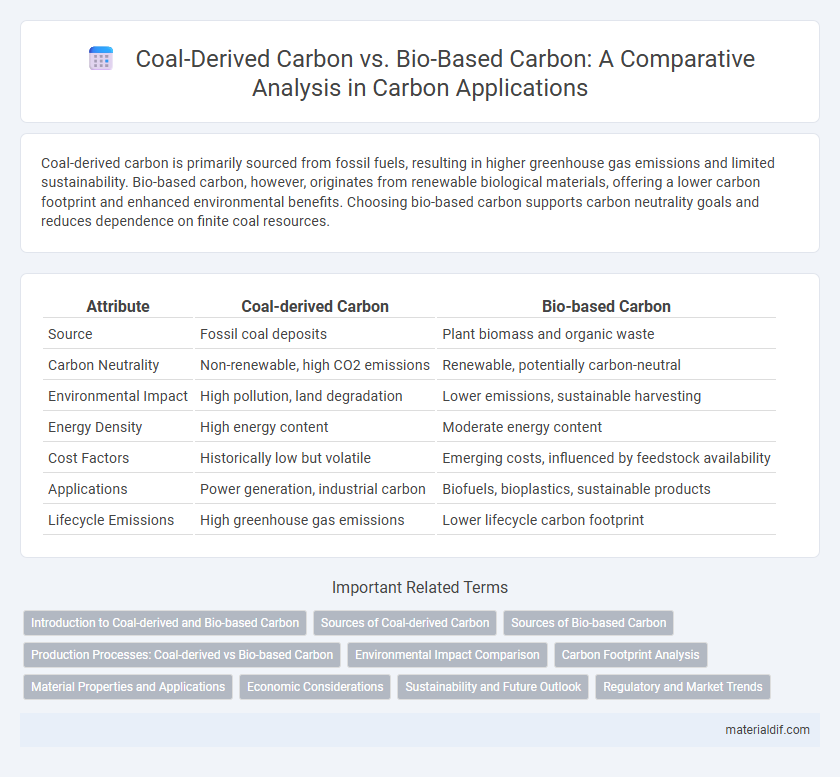Coal-derived carbon is primarily sourced from fossil fuels, resulting in higher greenhouse gas emissions and limited sustainability. Bio-based carbon, however, originates from renewable biological materials, offering a lower carbon footprint and enhanced environmental benefits. Choosing bio-based carbon supports carbon neutrality goals and reduces dependence on finite coal resources.
Table of Comparison
| Attribute | Coal-derived Carbon | Bio-based Carbon |
|---|---|---|
| Source | Fossil coal deposits | Plant biomass and organic waste |
| Carbon Neutrality | Non-renewable, high CO2 emissions | Renewable, potentially carbon-neutral |
| Environmental Impact | High pollution, land degradation | Lower emissions, sustainable harvesting |
| Energy Density | High energy content | Moderate energy content |
| Cost Factors | Historically low but volatile | Emerging costs, influenced by feedstock availability |
| Applications | Power generation, industrial carbon | Biofuels, bioplastics, sustainable products |
| Lifecycle Emissions | High greenhouse gas emissions | Lower lifecycle carbon footprint |
Introduction to Coal-derived and Bio-based Carbon
Coal-derived carbon is primarily extracted from fossil coal deposits formed over millions of years, making it a non-renewable resource with significant carbon content used in energy production and industrial applications. Bio-based carbon originates from recent biomass sources such as plants and organic waste, offering a renewable and potentially carbon-neutral alternative that supports low-carbon technologies. Understanding the distinct properties and environmental impacts of coal-derived versus bio-based carbon is crucial for advancing sustainable energy strategies and reducing greenhouse gas emissions.
Sources of Coal-derived Carbon
Coal-derived carbon originates primarily from ancient plant matter that has undergone geological transformation over millions of years, resulting in a dense, carbon-rich fuel source. It is extracted from sedimentary rock formations through mining techniques such as surface mining and underground mining. This type of carbon is predominantly used in energy production, steel manufacturing, and various industrial processes due to its high energy density and availability.
Sources of Bio-based Carbon
Bio-based carbon primarily originates from renewable organic materials such as agricultural residues, forestry waste, and dedicated energy crops like switchgrass and miscanthus. These sources absorb atmospheric CO2 during growth, creating a sustainable carbon cycle that contrasts with the fossil carbon locked in coal. Utilizing bio-based carbon reduces reliance on depleting coal reserves and supports carbon neutrality by promoting carbon sequestration through biomass regeneration.
Production Processes: Coal-derived vs Bio-based Carbon
Coal-derived carbon is produced by the thermal decomposition of coal through processes such as coking or gasification, involving high temperatures and chemical reactions that convert fossil carbon into solid carbon materials. Bio-based carbon, on the other hand, is generated from biomass sources like wood, agricultural residues, or algae, using methods such as pyrolysis or hydrothermal carbonization that transform organic matter into carbon-rich materials. These production processes differ significantly in terms of carbon origin, energy consumption, and environmental impact, with bio-based carbon offering renewable alternatives and lower net carbon emissions compared to coal-derived carbon.
Environmental Impact Comparison
Coal-derived carbon production releases high levels of greenhouse gases and toxic pollutants, contributing significantly to climate change and air quality degradation. Bio-based carbon, sourced from renewable biomass, offers a lower carbon footprint by sequestering CO2 during feedstock growth and enabling more sustainable lifecycle emissions. Transitioning to bio-based carbon reduces dependence on fossil fuels and supports circular economy principles, minimizing environmental harm and enhancing carbon neutrality efforts.
Carbon Footprint Analysis
Coal-derived carbon typically exhibits a higher carbon footprint due to substantial greenhouse gas emissions during extraction and combustion processes. Bio-based carbon sources often result in lower net carbon emissions as they capture atmospheric CO2 during growth, contributing to a more sustainable carbon cycle. Life cycle assessments consistently show bio-based carbon materials offer significant reductions in carbon footprint compared to conventional coal-derived carbon.
Material Properties and Applications
Coal-derived carbon exhibits high hardness, thermal stability, and electrical conductivity, making it ideal for industrial applications such as electrodes, refractories, and carbon composites. Bio-based carbon, produced from biomass through pyrolysis, offers enhanced porosity, lower density, and renewable sourcing, which suits applications in energy storage, filtration, and sustainable materials. The distinct microstructure and environmental footprint differentiate coal-derived carbon's robustness from bio-based carbon's eco-friendly advantages in advanced material design.
Economic Considerations
Coal-derived carbon remains economically competitive due to established mining infrastructure and abundant reserves, leading to lower production costs in many regions. Bio-based carbon, while often more sustainable, typically incurs higher expenses linked to biomass cultivation, processing, and land use. Market trends increasingly favor bio-based carbon as policy incentives and carbon pricing mechanisms aim to internalize environmental externalities, potentially shifting economic viability over time.
Sustainability and Future Outlook
Coal-derived carbon, sourced from finite fossil fuels, significantly contributes to greenhouse gas emissions and environmental degradation, posing challenges for long-term sustainability. Bio-based carbon, produced from renewable biomass, offers a lower carbon footprint and enhanced biodegradability, aligning with circular economy principles and climate goals. Advancements in bio-based carbon technologies and scaling efforts indicate a promising future, with potential to replace coal-derived carbon in various industrial applications and reduce overall carbon emissions.
Regulatory and Market Trends
Coal-derived carbon faces tightening regulations due to its high carbon emissions and environmental impact, leading to increased costs under carbon pricing and stricter emission standards globally. Bio-based carbon gains market traction as sustainable alternatives align with growing regulatory incentives, such as subsidies, carbon credits, and mandates for renewable content in various industries. Market trends reveal a shift towards bio-based carbon driven by consumer demand for eco-friendly products and corporate ESG commitments promoting low-carbon supply chains.
Coal-derived Carbon vs Bio-based Carbon Infographic

 materialdif.com
materialdif.com